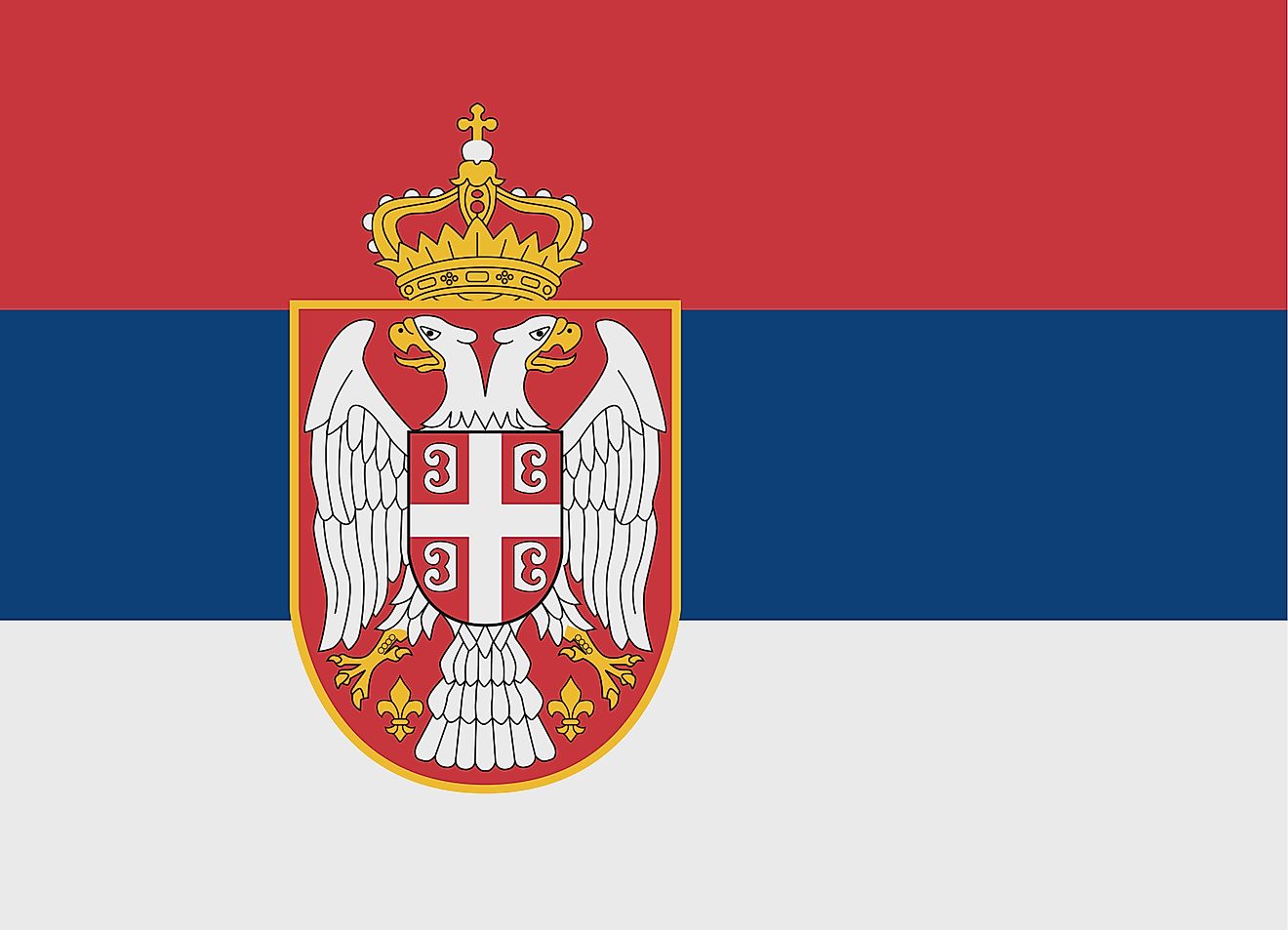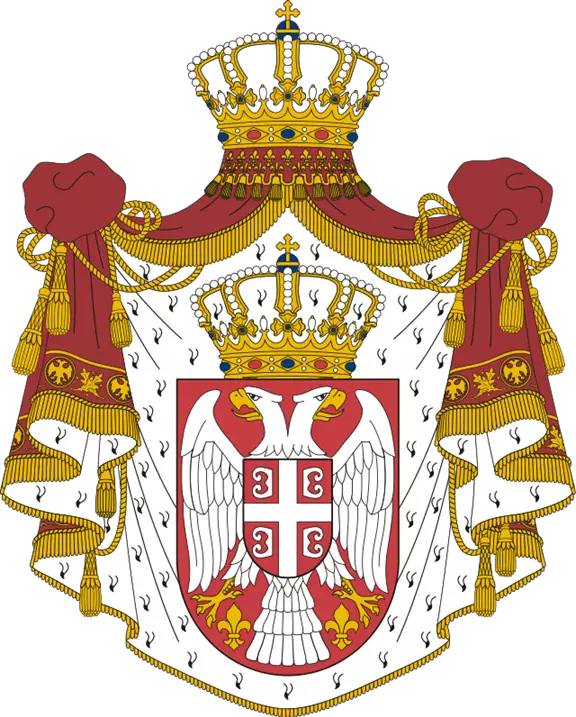The Serbian flag is a relatively recent design, officially adopted on November 11, 2010. However, its tricolour pattern and symbolic elements have deep historical roots.

Featuring horizontal stripes of red, blue, and white alongside a double-headed eagle, the flag proudly reflects its Slavic heritage and cultural identity.
What does the Serbian flag symbolize?
The Serbian flag prominently features the Pan-Slavic colours: red at the top, blue in the middle, and white at the bottom, arranged in three horizontal stripes. These colours, symbolic of Slavic unity and identity, trace their origins to the mid-19th century Pan-Slavic movement. On the hoist side of the flag, the Serbian coat of arms is proudly displayed, adding a layer of national significance. This emblem, featuring a crowned double-headed eagle and a cross with four firesteels, reflects Serbia’s rich historical and cultural heritage.
Unlike the flags of Western European nations, the Commonwealth countries, or Anglophone states like the United States, the Serbian flag embodies distinctively Slavic influences. Its design ties Serbia to a broader cultural and historical context, setting it apart from the Western tradition while celebrating its unique national identity within the Slavic world.
How come Red, White, and Blue are Slavic colours?
Since 1848, the colours red, blue, and white have been associated with nations of Slavic heritage. The Pan-Slavic Congress in Prague adopted these colors, inspired by the Russian flag, but inverted them for their own use.
Russia’s tricolour, in turn, was derived from the Imperial Russian banner, designed by Tsar Peter the Great and his efforts to modernize the Russian fleet. His inspiration came from the Dutch tricolour, which he encountered on Dutch ship. This was a testament to the Netherlands’ influence on the evolution of these symbolic colours.
It is fitting, however, that the Pan-Slavic colours are rooted in the flag of Russia, the largest and most powerful Slavic nation. This connection underscores the cultural and historical ties among Slavic peoples, while also highlighting Russia’s significant influence within the region.

On the Serbian flag, these colours take on a distinct meaning. Given Serbia’s complex and often tumultuous history, the emphasis on national sovereignty resonates deeply, not just for Serbians but for the entire Balkan region. The flag’s design serves as a reminder of the enduring struggle for self-determination and unity among the Slavic nations.
Now, on the Serbian flag, the colours specifically emphasize the revolutionary ideas of sovereignty. With Serbia’s tumultuous history, national sovereignty has been an issue not just for the Serbians, but for the people of the entirety of the Balkans.
The colours stand for the following:
- Red: Like in many countries, this is for the blood shed by Serbs fighting for the nation’s independence.
- Blue: To represent the pure, eternal Serbian sky.
- White: Bright light, and for a peaceful country.
A brief history
The origins of the modern Serbian flag can be traced back to the Serbian Revolt against the Ottoman Empire in 1804. During this time, Serbia sought assistance from Russia, which saw itself as the ‘elder brother’ and protector of smaller Slavic nations. However, politics came into play, and Russia agreed to provide military and financial support on the condition that Serbia send a delegation to participate in a Russian parade.
At that point, Serbia did not have an official flag to represent itself. An agreement was made to adopt a flag featuring the Pan-Slavic colours, inspired by the Russian tricolour but inverted. This design was later officially recognised by the Ottoman Sultan in 1835.
After securing independence in 1878, Serbia established a national flag consisting of the red-blue-white Pan-Slavic tricolour, emblazoned with the Serbian coat of arms. This design remains the basis of the Serbian flag as we know it today.

After the First World War and the collapse of the neighbouring Austro-Hungarian Empire, the Balkans became a complex mosaic of ethnicities seeking nation-states to call their own. Serbia joined the newly formed Kingdom of Serbs, Croats, and Slovenes — later officially named Yugoslavia, meaning “Land of Southern Slavs.”
To avoid favouring any particular ethnic group, the kingdom initially refrained from adopting an official flag. Eventually, it embraced a blue-white-red tricolour, reflecting the Pan-Slavic ideals upon which the state was founded.
In 1947, following the Second World War, the Federal People’s Republic of Yugoslavia introduced a red-blue-white tricolour flag for Serbia and other constituent republics. This version featured a red communist star with a gold outline, symbolising the dawn of a new communist era.
The modified flag represented not only Serbia but also the diverse ethnic groups within Yugoslavia, including Croats, Slovenes, Bosniaks, Montenegrins, Macedonians, and various minorities. This marked a new chapter in the flag’s history, serving as a visual representation of the state’s socialist identity.

In 1992, as Yugoslavia disintegrated and the communist era came to an end, Serbia adopted a new flag that omitted the red star. Following Montenegro’s secession from the federation in 2006, Serbia introduced another flag, which remained in use until 2009.
In 2010, the current version of Serbia’s state flag was officially adopted. This design features the red, blue, and white tricolour adorned with the Serbian coat of arms, symbolising the nation’s sovereignty and historical continuity. This flag has been in use ever since.
How can I see the flag for myself?
Reflecting the significance of Serbia’s history, culture, and complex past, Young Pioneer Tours has extensively explored this fascinating nation over the years.
We currently run our Ultimate Yugoslavia Tour twice a year, in November and May, which includes time in Serbia. If you’d like to extend your time in the country, we’d be happy to help arrange that for you.
For those seeking a more tailored experience or a completely exclusive itinerary, we can organise private tours to suit your interests. Check out our Serbia page or drop us an email — we’re always happy to help!





